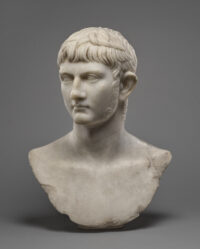 The Getty Museum has acquired an extraordinary 1st century portrait bust of Germanicus Julius Caesar, triumphant general, grandson of Mark Anthony, grand-nephew of the emperor Augustus, nephew and adopted son of Augustus’ successor Tiberius, father of Tiberius’ successor Caligula and older brother of Caligula’s successor Claudius.
The Getty Museum has acquired an extraordinary 1st century portrait bust of Germanicus Julius Caesar, triumphant general, grandson of Mark Anthony, grand-nephew of the emperor Augustus, nephew and adopted son of Augustus’ successor Tiberius, father of Tiberius’ successor Caligula and older brother of Caligula’s successor Claudius.
“This stunning portrait bust adds an extraordinary sculpture to the Villa’s collection of Roman portraits,” says Timothy Potts, Maria Hummer-Tuttle and Robert Tuttle Director of the J. Paul Getty Museum. “It is among the finest and best-preserved portraits of the young Germanicus at the time of his adoption in AD 4 by his uncle, the soon-to-be Roman emperor Tiberius and complements nicely other Roman busts in the antiquities collection at the Villa.”
The bust depicts the young Germanicus before the depositio barbae, the Roman ritual first shaving of the beard. While the image, or portrait type, was created at the time of his adoption, this bust is a posthumous portrait of the popular general, who was being groomed to be emperor but died young. Ten copies are known today of Germanicus’ “Adoption type” portrait—identified by the facial features and careful arrangement of the locks of hair over the forehead.
While the original of the portrait type was likely carved after Germanicus’ adoption in 4 A.D., the copies are believed to have been made in the reign of Caligula or a few years into Claudius’ (ca. 37-45 A.D.). Germanicus was still enormously beloved by the Roman people when Caligula ascended the throne, and the new emperor promoted his father and their connection with portraiture of Germanicus as the brilliant young general destined for imperial greatness before his untimely (and highly suspicious) death at age 33.
The bust’s documented ownership history goes back to 1798-99 when it was bought in Rome by Thomas Bruce, 7th Earl of Elgin, despoiler of the Parthenon Frieze. Elgin, on his way to Constantinople to serve as ambassador to the Ottoman Empire, had his private secretary buy “marbles” in Rome and ship them to Constantinople to decorate the official residence of the ambassador. His term ended in 1803, and the statuary was shipped to Broomhall House in Scotland, seat of the Earls of Elgin. Germanicus stayed in Broomhall for two centuries until it was sold at auction by Elgin’s descendants in 2012 for an eye-watering $8,146,500.
The bust will first be displayed in December 2021 as part of an exhibition highlighting new acquisitions–Recent Acquisitions 2021: Collecting for the Museum–at the Getty Center and then go on permanent view at the Getty Villa Museum in the Early Roman Imperial Sculpture gallery in 2022.